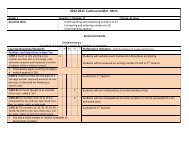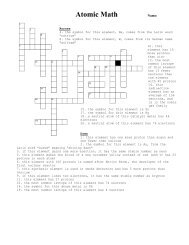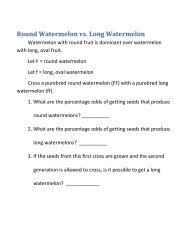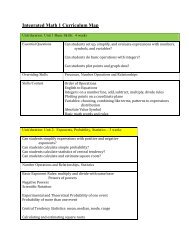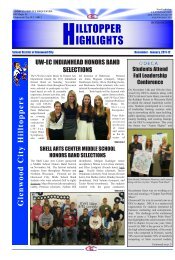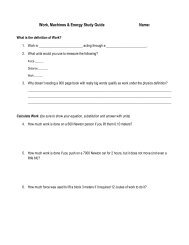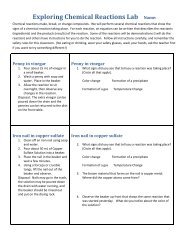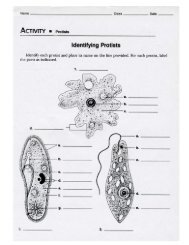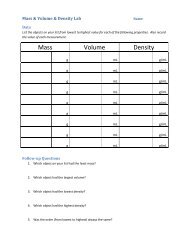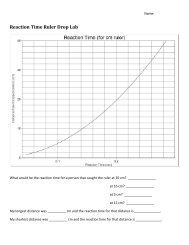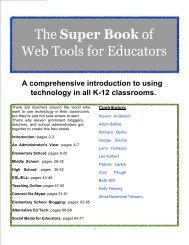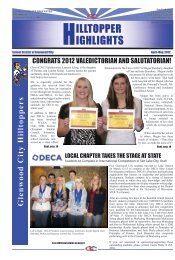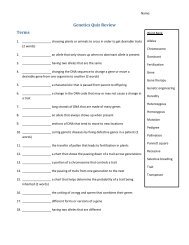Physical Science Test #1 â Review Guide Properties of Matter ...
Physical Science Test #1 â Review Guide Properties of Matter ...
Physical Science Test #1 â Review Guide Properties of Matter ...
- No tags were found...
Create successful ePaper yourself
Turn your PDF publications into a flip-book with our unique Google optimized e-Paper software.
<strong>Properties</strong> <strong>of</strong> <strong>Matter</strong><strong>Physical</strong> <strong>Science</strong> <strong>Test</strong> <strong>#1</strong> – <strong>Review</strong> <strong>Guide</strong>1. A characteristic <strong>of</strong> matter that can be measured or observed is a _________________________ <strong>of</strong> that matter.2. _______________________________ properties describe the object, while _______________________________ propertiesdescribe the material the object is made <strong>of</strong>.3. Decide if each property below is extensive (E) or intensive (I)a. _____ A rock has a mass <strong>of</strong> 45 grams.b. _____ The rock has a volume <strong>of</strong> 12.3 mL.c. _____ The rock has a density <strong>of</strong> 3.66 g/mL.d. _____ The rock is not flammable.e. _____ The rock is shaped like a peanut.f. _____ The rock reacts with acid, creating bubbles.4. <strong>Properties</strong> that describe how matter interacts with other matter are __________________________ properties.5. Decide if each property below is a physical (P) or chemical (C) property.a. _____ The rock is easily crushed with a hammer.b. _____ The rock has a mass <strong>of</strong> 45 grams.c. _____ The rock reacts with acid, creating bubbles.d. _____ The rock is not flammable.e. _____ The rock has a density <strong>of</strong> 3.66 g/mLf. _____ The rock sinks in water.g. _____ The rock is a solid.h. _____ The rock is pink.i. _____ The rock tastes salty (hint: you really can’t tell this unless you let it “react” with yourtastebuds).Measuring <strong>Properties</strong> – Mass, Volume, Density6. A measure <strong>of</strong> the amount <strong>of</strong> matter in an object is the ______________________ <strong>of</strong> the object.7. A measure <strong>of</strong> the amount <strong>of</strong> space occupied by that object is the ______________________ <strong>of</strong> the object.8. A calculated property that uses both <strong>of</strong> the last two properties is ______________________ and describeshow close together or far apart the atoms in that object are.9. What unit did you measure mass in for your lab?
10. Name an object with a mass <strong>of</strong> about 1 gram.11. What unit did you measure volume in for your lab?12. Describe in detail, how you could measure the volume <strong>of</strong> your hand by water displacement.(Remember to name all the equipment you used, and describe the steps you would take to use it.)13. How would you measure and calculate the volume <strong>of</strong> a box <strong>of</strong> tissues?14. What two things do you need to know to calculate density?15. If 45 mL <strong>of</strong> a liquid has a mass <strong>of</strong> 40 grams, what would its density be?16. Would that liquid sink in or float on water? How do you know?Classification <strong>of</strong> <strong>Matter</strong>17. <strong>Matter</strong> is anything that has ___________________ and has ____________________.18. A ____________________________________ is made up <strong>of</strong> one kind <strong>of</strong> atom or molecule (like elements andcompounds).19. A __________________________ is made up <strong>of</strong> more than one kind <strong>of</strong> atom or molecule in the same place atthe same time (but those atoms or molecules are NOT bonded together).20. ________________________________ are made up <strong>of</strong> one kind <strong>of</strong> atom; for example: carbon, oxygen, hydrogen,sodium, or chlorine.21. ________________________________ are made up <strong>of</strong> atoms <strong>of</strong> more than one kind that are BONDED together;for example: water, carbon dioxide, sodium chloride, glucose.22. Decide if each formula below is for an Element (E) or Compound (C)a. ______ Kb. ______ KClc. ______ MnO 2
d. ______ N 2e. ______ SiO 2f. ______ Xeg. ______ Coh. ______ CO23. Name the 5 types <strong>of</strong> mixtures that we talked about in class, and list an example <strong>of</strong> each type.Type <strong>of</strong> MixtureExampleDalton’s Atomic Theory and Parts <strong>of</strong> an Atom24. List the 5 ideas that make up Dalton’s Atomic Theory25. Fill in the blanks in the chart below about the parts <strong>of</strong> an AtomParticle Name Location Mass ChargeProtonIn the nucleusNeutron1 amu−
Answers:1. Property2. Extensive, Intensive3. a.E b.E c.I d.I e.E f.I4. chemical5. a.P b.P c.C d.C e.P f.P g.P h.P i.C6. mass7. volume8. density9. grams (g)10. (a plain M&M, a large paper clip, etc.)11. Milliliters (mL)12. Fill an overflow can with water and let it set until it stops dripping. Hold a graduated cylinder under thespout. Slowly sink your hand into the water in the can, catching the water in the graduated cylinder as itflows out <strong>of</strong> the spout. Measure the water displaced in the cylinder.13. Use a ruler to measure the length and width and height <strong>of</strong> the box. Multiply these three numbers to getthe volume <strong>of</strong> the box.14. Mass and volume15. D=m÷V D = 40g÷45mL D= 0.89 g/mL16. It would float in water because its density is less than 1 g/mL.17. Mass, volume18. Pure substance19. Mixture20. Elements21. Compounds22. a.E b.C c.C d.E e.C f.E g.E h.C (one capital letter=element, more than one capital letter=compound)23. suspensions(muddy water), colloids(smoke,milk,fog), solutions(salt water, Kool-Aid), alloys(steel, brass),emulsions(oil and vinegar salad dressing, greasy dishwater)24. all matter is made <strong>of</strong> atoms, atoms <strong>of</strong> the same element are alike, atoms <strong>of</strong> different elements aredifferent, atoms combine (bond) to make compounds, atoms cannot be created or destroyed by chemicalor physical reactions25. (only the blanks, from left to right, top to bottom) 1amu, +, In the nucleus, none(neutral), Electron, Aroundthe nucleus, 0 amu



